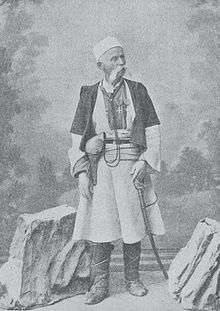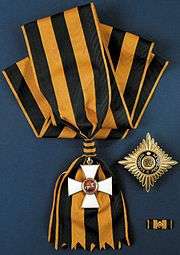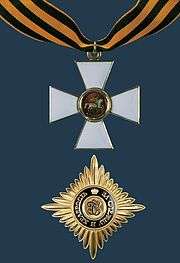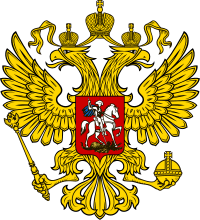Order of St. George
The Order of Saint George (Russian: Орден Святого Георгия, Orden Svyatogo Georgiya) is today the highest purely military decoration of the Russian Federation. Originally established 26 November 1769 as the highest military decoration of the Russian Empire by Empress Catherine the Great.[3] After the 1917 Russian Revolution it was awarded by the White movement anti-communist forces under Alexander Kolchak until their collapse in 1921.[4] The order was revived in the Russian Federation on 8 August 2000 by Decree №1463[2][5] of the President of Russia. The current award criteria were amended on 7 September 2010 by Presidential Decree 1099.[6][7]
| Order of Saint George | |
|---|---|
 The Order of Saint George IV class | |
| Awarded by | |
| Type | Military order |
| Established | 26 November 1769, revived on 20 March 1992[1][2] |
| Eligibility | Top and senior military officers |
| Awarded for | Distinction in combat |
| Status | Active |
| Classes | 1st, 2nd, 3rd, 4th |
| Precedence | |
| Next (higher) | Order of Saint Andrew |
| Next (lower) | Order For Merit to the Fatherland |
Ribbon of the Order of Saint George, first class | |
Statute of the Order of St. George


The current Order of Saint George is awarded to highest and senior military officers for the conduct of military operations to protect the Fatherland from attack by an external enemy which resulted in the complete defeat of the enemy, for the execution of combat and other operations in other states aimed at restoring international peace and security, or for being a model of military science with feats that exemplify military prowess; the Order is also conferred upon officers who were previously awarded state awards of the Russian Federation for distinction in combat.[8]
Description
The Order of Saint George is divided into four classes, from the First Class to the Fourth class; the highest degree being the Order First class. The four classes are awarded sequentially from the fourth to the first. These four classes are individually identified by the size and manner of wearing the two principal insignia of the Order, the cross and the star.[8]


Cross: A white enamelled cross pattée with a central medallion bearing the image of Saint George on horseback slaying the dragon. The cross measures 60mm across in the case of the Order first class and is worn on a sash in the colours of Saint George (orange and black). The same 60mm cross is worn around the neck on a 45mm wide ribbon also in the colours of Saint George for the Order second class. The cross is 50mm across for the Order third class and is also worn around the neck but from a 24mm wide ribbon in the same colours. The Order fourth class is a 40mm cross worn on the left breast hanging from a pentagonal mount covered with a 24mm wide ribbon of Saint George.[8]
Star: A four-pointed silver gilt star with a gold central medallion bearing the cipher of Saint George "SG" topped by a crown and surrounded by a black enamelled band bearing the motto of the order "For Service and Bravery" ("Za Sluzhbu i Khrabrost"). The star is worn on the left breast for both the Order first and second classes.[8]
Ribbon: The ribbon of the Order of Saint George is orange with three black stripes, commonly called "George's Ribbon". It symbolises fire and gunpowder: the Russian "colors of military glory", and is also thought to be derived from the colours of the original Russian imperial coat of arms (black eagle on a golden background). It was subsequently associated to the colors of the Russian Guard units.[8] Unlike the other classes, the Order of Saint George fourth class can be awarded to junior officers while the rest is for senior and flag officers.




Recipients (partial list)
Recipients of the Order first class
- Field Marshal of the Russian Empire Mikhail Kutuzov
- Field Marshal of the Russian Empire Barclay de Tolly
- Marshal of the Soviet Union Semyon Budyonny
- General Yevgeni Iskritsky
- Nikifor Grigoriev, Ukrainian ataman (twice)
- Dmitry Shmidt, Russian Imperial Army battalion commander and Red Army general
- Petr Efimovich Shchetinkin, Imperial Army staff captain and Red Army general
- Stepan Zotov, Cossack khorunzhyi and Red Army general
- Alexander Sirotkin, Tsarist Army poruchik and Red Army general
- King Carl XIV Johan of Sweden as Commander of the Coalition Army of the North against Napoleon [9]
Recipients of the Order second class
- General of the Army Nikolay Yegorovich Makarov[10]
- Colonel General Alexander Zelin[10]
- General of the Army Vladimir Boldyrev[10]
- Marshal of the Soviet Union Semyon Budyonny
- Dmitry Shmidt, Russian Imperial Army battalion commander and Red Army general
- Petr Efimovich Shchetinkin, Imperial Army staff captain and Red Army general
- Stepan Zotov, Cossack khorunzhyi and Red Army general
- Alexander Sirotkin, Tsarist Army poruchik and Red Army general
- Marshal of France Ferdinand Foch
- Grand Duke Nicholas Nikolaevich of Russia (1856–1929)
- Field Marshal of the Russian Empire Mikhail Kutuzov
- Field Marshal of the Russian Empire Barclay de Tolly
Recipients of the Order third class
- King Leopold I of Belgium.
- Grand Duke Nicholas Nikolaevich of Russia (1856–1929)
- Field Marshal of the Russian Empire Mikhail Kutuzov
- Field Marshal of the Russian Empire Barclay de Tolly
- General Alexei Brusilov
- General Yevgeni Iskritsky
- General Samad bey Mehmandarov
- Marshal of the Soviet Union Georgy Zhukov
- Marshal of the Soviet Union Vasily Blyukher
- Marshal of the Soviet Union Semyon Budyonny
- Dmitry Shmidt, Russian Imperial Army battalion commander and Red Army general
- Petr Efimovich Shchetinkin, Imperial Army staff captain and Red Army general
- Stepan Zotov, Cossack khorunzhyi and Red Army general
- Alexander Sirotkin, Tsarist Army poruchik and Red Army general
Recipients of the Order fourth class
- Nicholas II of Russia
- Grigory Kotovsky, Imperial Army praporshchik and Red Army general
- Jukums Vācietis, Latvian rifleman, Tsarist colonel and the first Commander-in-Chief of the Red Army
- General Mikhail Dmitrievich Bonch-Bruevich
- General Alexei Brusilov
- General Yevgeni Iskritsky
- Marshal of the Soviet Union Georgy Zhukov
- Marshal of the Soviet Union Vasily Blyukher
- Marshal of the Soviet Union Semyon Budyonny (twice)
- Vladimir Gittis, Imperial colonel and Red Army general
- Filipp Mironov, Imperial colonel of the Cossacks and Red Army general
- Dmitry Shmidt, Russian Imperial Army battalion commander and Red Army general
- Petr Efimovich Shchetinkin, Imperial Army staff captain and Red Army general
- Stepan Zotov, Cossack khorunzhyi and Red Army general
- Alexander Sirotkin, Tsarist Army poruchik and Red Army general
- Nikolai Gikalo, Bolshevik revolutionary and Tsarist Army paramedic
- Colonel Lambros Katsonis, Greek 18th century revolutionary
- Colonel General Sergei Makarov[10]
- Lieutenant General Vladimir Shamanov[10]
- Lieutenant Colonel Anatoly Lebed[10]
- British Captain Albert Ball, World War I fighter pilot
- Dutch War Correspondent Louis Grondijs, World War I, White Army, Russian Civil War
- Major General Carl Gustaf Emil Mannerheim, Imperial Russia, WWI
- General Pyotr Nikolayevich Wrangel, Imperial Russia, World War I, White Army, Russian Civil War
- Brigadier John Alexander Sinton, Indian Army, WWI
- Field Marshal Franz Joseph, Emperor of Austria and King of Hungary
- Major General Hermann Christoph Gamper, Imperial Russian cavalry commander during the Patriotic War of 1812
- African Spir (Battle of Malakoff, 1855)
- Baron Roman Von Ungern-Sternberg
- Field Marshal of the Russian Empire Mikhail Kutuzov
- Field Marshal of the Russian Empire Barclay de Tolly
- Ilija Plamenac, Montenegrin vojvoda and military commander
- Bogdan Zimonjić, Orthodox priest, Montenegrin vojvoda, Senator and military commander
- Robert Quigg, Northern Irish soldier
- Anatoly Pepelyayev, White Russian general
See also
- Cross of Saint George
- Gold Sword for Bravery
- Ribbon of Saint George
- Awards and decorations of the Russian Federation
References
- Постановление Верховного Совета Российской Федерации от 20 марта 1992 года N0 2557-I Archived 2012-07-18 at the Wayback Machine
- "Decree of the President of the Russian Federation of August 8, 2000 No 1463" (in Russian). Commission under the President of the Russian Federation on state awards. 2000-08-08. Archived from the original on March 11, 2012. Retrieved 2012-02-11.
- Hurley, C. Russian Orders, Decorations, and Medals Under the Monarchy. Harrison & Sons., Ltd., London. 1935.
- "St George's Cross, 4th Class, awarded to 2nd Lt. John Mitchell 1919". Fitzwilliam Museum. University of Cambridge. Archived from the original on 23 October 2017. Retrieved 4 June 2017.
- Decree 1463 of 2000 (pravo.gov.ru)
- "Decree of the President of the Russian Federation of September 7, 2010 No 1099" (in Russian). Russian Gazette. 2010-09-07. Retrieved 2012-02-07.
- Decree 1099 of 2010 (pravo.gov.ru)
- "Statute of the Order of St. George" (in Russian). Commission under the President of the Russian Federation on state awards. 2000-08-08. Retrieved 2012-02-11.
- Barton, Sir Dunbar Plunket. (1925) "Bernadotte: Prince and King." P. 96. John Murray, London.
- "Compiled from the site of the President of the Russian Federation" (in Russian). Kremlin News. Retrieved 2012-02-07.
Further reading
- Voennyĭ orden sviatogo velikomuchenika i pobedonostsa Georgiia: imennye spiski 1769 - 1920; biobibliograficheskiĭ spravochnik / otvetstvennyĭ sostavitel' V. M. Shabanov. Moskva 2004, ISBN 5-89577-059-2
External links
- The Commission on State Awards to the President of the Russian Federation

